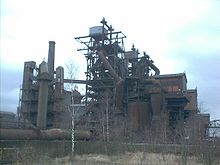Heavy industry

Heavy industry is a collective term for mining , iron and steel industry and open-cast mining as well as " heavy chemistry ". In a broader sense, it also refers to other basic industries. Areas of heavy industry are characterized by mines , blast furnaces , foundries , steel and rolling mills, coal heaps , ore heaps, transport facilities and large work areas.
The rise of heavy industry began with the industrial revolution . In particular, the high demand for steel and coal in the railways , shipbuilding and, in the early 20th century, the armaments industry , led to the flourishing of heavy industry from the end of the 19th century to the end of the Second World War .
After the Second World War, the economic focus in the industrialized countries shifted to the consumer goods and service sectors . This resulted in the centers of heavy industry such as B. the Ruhr area , to considerable social problems due to the high unemployment due to the closure of numerous companies.
Important centers of heavy industry include the Ruhr area and Saarland in Germany, the Charleroi and Liège agglomerations in Belgium , the Esch / Differdingen area in Luxembourg and large parts of northern Lorraine in France.
See also
literature
- Oskar Stillich : Iron and steel industry . Economic research in the field of large-scale industrial enterprise Volume 1; Publisher Franz Siemeroth, Berlin 1904
- Oskar Stillich: The hard coal industry . Political economic research in the field of large-scale industrial enterprise Volume 2; Jäh & Schunke publishing house, Leipzig 1906
